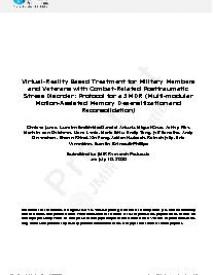Virtual-Reality Based Treatment for Military Members and Veterans with Combat-Related Posttraumatic Stress Disorder : Protocol for a 3MDR (Multi-modular Motion-Assisted Memory Desensitization and Reconsolidation)
Background: Military members (MMs), including Canadian Armed Forces (CAF) Service members (SMs), and Veterans are at elevated risk of experiencing occupational traumas which can cause operational stress injuries (OSIs) including post-traumatic stress disorder (PTSD), and moral injury (MI). Traditional evidence-based psychotherapeutic interventions can be effective in
reducing symptoms of PTSD. Some MMs and Veterans, however, are less responsive to these treatments and considered to have Treatment-Resistant PTSD (TR-PTSD). Multi-modular Motion-Assisted Memory Desensitization and Reconsolidation (3MDR) is an intervention delivered within a virtual reality (VR) environment that has been introduced to MMs and Veterans who experience PTSD related to military service. Utilizing the Computer-Assisted Rehabilitation Environment (CAREN), 3MDR incorporates exposure therapy, psychotherapy, Eye Movement Desensitization and Reconsolidation (EMDR), VR, supportive counselling, and treadmill walking.
Objective: To (1) investigate whether 3DMR reduces PTSD symptoms among CAF-SM and Veterans with combat-related TRPTSD and who have not optimally responded to previous trauma therapies, (2) examine the technology acceptance and usability of the CAREN and 3MDR by CAF-SMs, Veterans, as well as 3MDR clinicians and operators, and; (3) evaluate the impact of
3MDR on the clinicians and operators delivering the intervention.
Methods: This 2-year mixed-methods waitlist controlled pilot study utilizes a cross-over design. Participants include: (1) CAFSMs and Veterans (N=40) aged 18-60 years with combat-related TR-PTSD for whom had previously engaged in at least 2 evidence-based trauma treatments, and; (2) Clinicians and operators (N=12) who have delivered the 3MDR intervention. The
CAF-SMs and Veterans will engage in 3MDR for 90- minute sessions once a week for 6 weeks. Quantitative and qualitative data will be collected pre/post-intervention, and at 1, 3 and 6 month post-intervention. Data capture will include outcome measures, biomarkers, eye-tracking, electroencephalogram (EEG), physiological data, and semi-structured interviews. Outcome measures will aim to measure symptoms of PTSD and moral injury, resilience, technology acceptance and usability, among others. Biomarker analysis will include blood and saliva cortisol, proteins, inflammatory markers, and microRNA. Mixed-methods data analysis will involve repeated measures linear regression analysis and thematic analysis of treatment sessions and interviews. Machine learning will also be trialed in an attempt to identify individual data patterns that may predict diagnosis, severity, and potentially treatment outcomes. To attain a medium effect size, a minimum of N=34 is needed, with 17 participants in each of the intervention and control groups.
Results: Data will be analysed and interpreted upon conclusion of the 2-year data collection period. Conclusions: This 3MDR study will add to the international literature on this emerging intervention and be first to utilize and explore eye tracking, blood biomarkers, technology acceptance and usability, moral injury, resilience, machine learning, and the experience of clinician and operators delivering 3MDR. Clinical Trial: ISRCTN: 11264368
Geachte bezoeker,
De informatie die u nu opvraagt, kan door psychotraumanet niet aan u worden getoond. Dit kan verschillende redenen hebben,
waarvan (bescherming van het) auteursrecht de meeste voorkomende is. Wanneer het mogelijk is om u door te verwijzen naar de bron
van deze informatie, dan ziet u hier onder een link naar die plek.
Als er geen link staat, kunt u contact opnemen met de bibliotheek,
die u verder op weg kan helpen.
Met vriendelijke groet,
Het psychotraumanet-team.
In: JMIR Research Protocols ; ISSN 1929-0748 | 9 | 10 | e20620
https://doi.org/10.2196/20620


